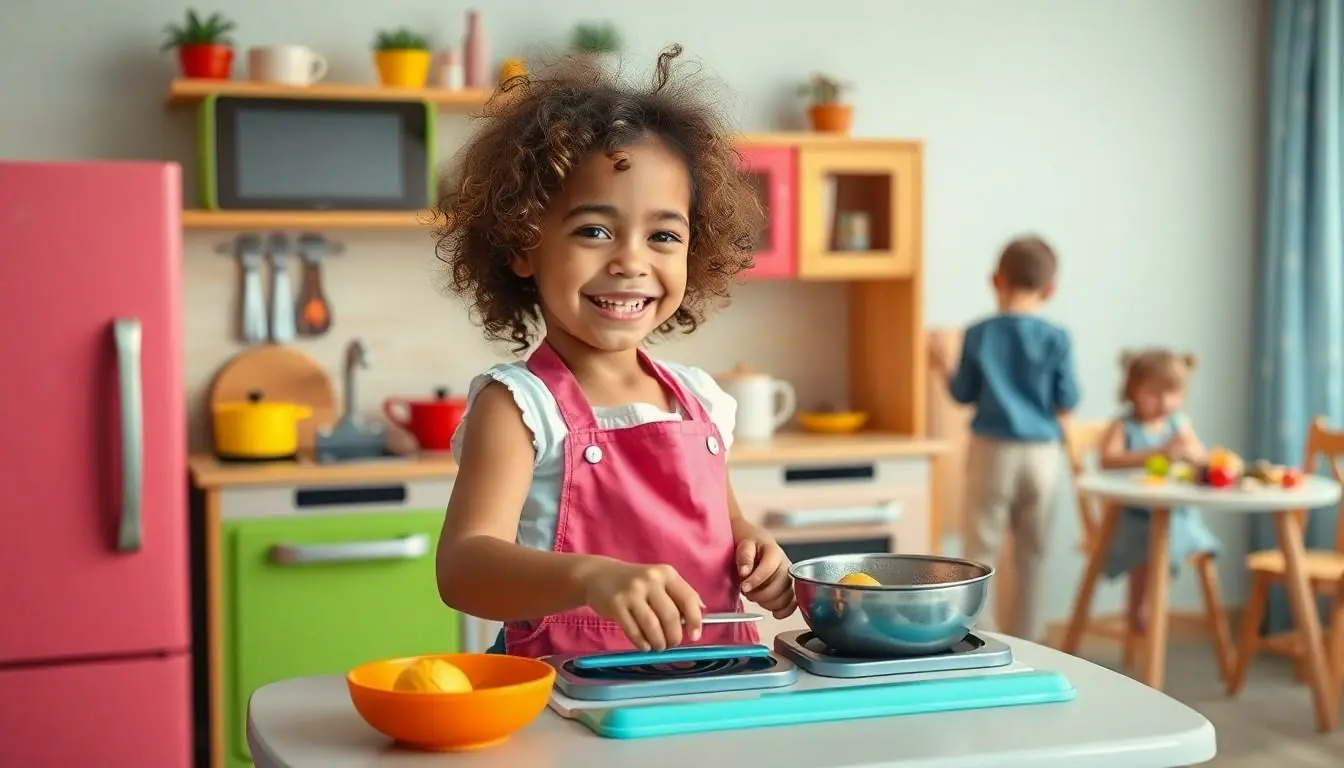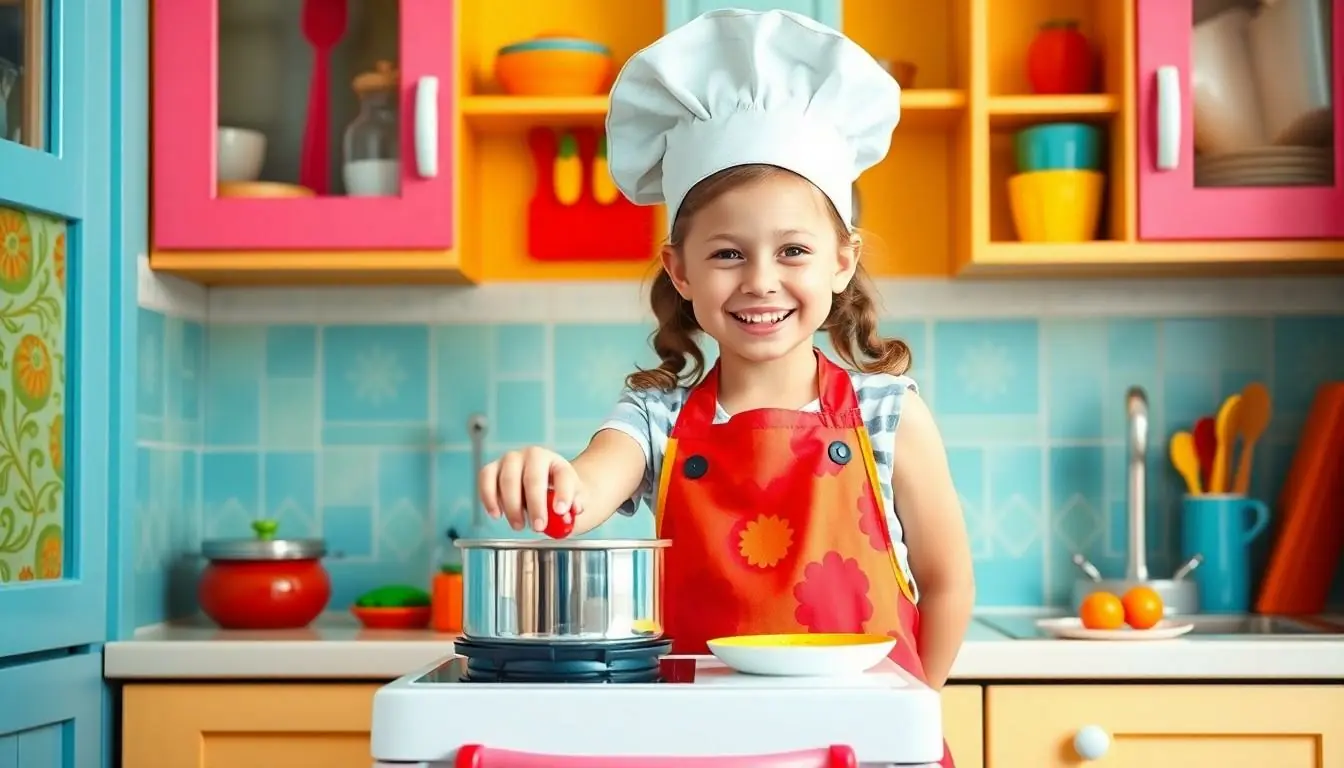Imagine a world where kids rule the kitchen, whipping up culinary masterpieces while wearing tiny chef hats and big smiles. Welcome to the delightful realm of kitchens for kids, where creativity meets fun and every meal becomes an adventure. These kid-friendly spaces aren’t just about stirring pots; they’re about sparking imagination and inspiring the next generation of culinary geniuses.
Table of Contents
ToggleOverview of Kitchens for Kids
Kitchens designed for kids create engaging environments that nurture creativity. These spaces feature kid-sized furniture and appliances, making cooking accessible. Safety becomes a priority in these areas, encouraging children to explore culinary skills without hazards. Interactive elements engage children, fostering independence and confidence in their cooking abilities.
Various styles of children’s kitchens exist, from modern designs with sleek finishes to classic wooden ones. Some kitchens include pretend food and utensils, allowing for imaginative play. Popular brands create kitchens with realistic features, enhancing the cooking experience for young aspiring chefs.
In addition to creativity, these kitchens promote social interaction. They serve as gathering spots for children to collaborate on cooking projects, strengthening friendships. Through play, kids learn valuable skills such as teamwork and communication. Engaging in cooking activities also introduces fundamental math and science concepts, making learning fun.
Parents appreciate how kitchens for kids facilitate quality family time. Cooking together offers opportunities for bonding, sharing recipes, and exploring new cuisines. These kitchens often spark interest in healthy eating, encouraging children to try new foods and embrace nutrition from an early age.
Overall, children’s kitchens act as platforms for growth. They inspire imaginative play, facilitate skill development, and promote healthy habits. As children explore these vibrant cooking spaces, they embark on delicious culinary adventures, laying the foundation for future cooking experiences.
Types of Kitchens for Kids

Kitchens for kids come in several types, each tailored to different play styles and developmental needs. The options range from playful designs to realistic setups.
Play Kitchens
Play kitchens serve as imaginative spaces where children engage in pretend cooking. These kitchens often feature colorful, oversized appliances designed for children to safely explore their culinary creativity. Accessories like pretend food and utensils enhance role-playing activities, allowing kids to mimic real cooking experiences. Bright colors and playful decorations invite fun interactions, fostering creativity as children invent their own recipes. These kitchens not only spark imagination but also encourage social play, with kids often inviting friends to join their cooking adventures.
Realistic Cooking Stations
Realistic cooking stations provide mimicked kitchen experiences that resemble adult kitchens. These setups often include functional features such as working knobs, sinks, and realistic utensils. Materials used in these kitchens focus on durability and safety, ensuring children can explore cooking freely. Such kitchens promote hands-on learning while enhancing fine motor skills as kids chop, mix, and stir. They encourage independence, allowing children to follow simple recipes, fostering self-confidence in their culinary abilities. Realistic cooking stations lay the groundwork for future kitchen skills, blending play with practical learning.
Benefits of Kitchens for Kids
Kitchens for kids offer numerous advantages that enhance their development and enjoyment.
Encouraging Imagination and Creativity
These spaces spark imagination and stimulate creativity during cooking activities. Children transform into culinary artists, crafting meals using pretend food and accessories. Colorful appliances and playful designs inspire role-playing, allowing kids to explore diverse culinary scenarios. Engaging in imaginative play fosters teamwork as friends gather to cook together, sharing ideas and experiences. The environments also promote storytelling, as children narrate their cooking adventures. Ultimately, the blend of fun and creativity found in kitchens for kids encourages lifelong culinary interests.
Developing Motor Skills
Kitchens for kids help refine essential motor skills through hands-on activities. When children engage with age-appropriate utensils and tools, they practice gripping, stirring, and pouring. Fine motor skills improve as they follow simple recipes and manipulate various ingredients. Pouring liquids and cutting soft foods enhance coordination and precision. Tasks like setting the table and arranging food engage different muscle groups, promoting physical development. Overall, these activities build confidence as children master culinary tasks and take pride in their accomplishments.
Safety Features to Consider
Safety features play a crucial role in any kitchen designed for kids. Non-toxic materials ensure peace of mind during playtime and culinary exploration. Rounded edges on furniture and appliances minimize the risk of injury. An anti-slip surface on floors helps prevent falls as children move about.
Secure storage for small items prevents choking hazards while keeping essential tools accessible. Adjustable height options allow children to use the kitchen comfortably, fostering independence. Childproof locks on cabinets and drawers keep sharp utensils and cleaning supplies out of reach.
Ventilation is important for realistic cooking stations. Proper airflow reduces the buildup of smoke and odors, promoting a healthier space. Built-in timers can assist children in monitoring cooking times safely, enhancing their learning experience.
Many models incorporate soft-close mechanisms for doors and drawers. This feature prevents pinched fingers, ensuring a safer environment as kids play. Additionally, battery-operated or plug-free appliances reduce the risk of electrical hazards during imaginative cooking sessions.
Wheeled components enable easy movement, which may lead to stable setups during play. Clear instructions and safety guidelines help adults supervise children effectively while they experiment in the kitchen.
Choosing kitchens with safety features ensures an enjoyable experience without compromising well-being. Each consideration directly enhances the joy of cooking while allowing kids to explore their culinary skills safely.
Choosing the Right Kitchen for Your Child
Selecting the right kitchen for a child involves considering several essential factors. First, prioritize safety by looking for kitchens made from non-toxic materials with rounded edges. Such features reduce injury risks while kids play and explore.
Another essential aspect is size. Kitchen sets should be age-appropriate, allowing children to use them comfortably. Play kitchens often come in vibrant colors with oversized accessories, inviting imaginative role play. Realistic cooking stations may include functional elements like working knobs, providing a hands-on experience.
Durability matters, too. Choose kitchens built to withstand active play, ensuring they last through years of culinary adventures. Check for high-quality finishes that resist wear and tear from daily use.
Another factor involves the kitchen’s style. Options range from contemporary designs to classic wooden sets. It’s crucial to pick a style that aligns with the child’s preferences and the home decor, making the kitchen a cohesive part of the living space.
In addition, look for kitchens that include interactive features. Elements like sound effects, playful lights, or accessories can enhance engagement, making cooking exciting. These interactive aspects encourage creativity and collaboration among friends.
Lastly, consider the learning opportunities. Kitchens that incorporate educational elements help kids develop skills as they prepare simple recipes. By choosing a kitchen that supports both play and learning, parents set the stage for healthy habits and valuable life skills in their children.
Kitchens for kids serve as vibrant spaces that inspire creativity and learning. They not only foster imaginative play but also support important life skills that children will carry into adulthood. By encouraging hands-on cooking experiences, these kitchens help kids develop confidence and independence in the kitchen.
Parents can take comfort in knowing that these environments are designed with safety in mind, allowing children to explore without worry. Choosing the right kitchen can enhance family bonding time and create lasting memories. Ultimately, investing in a kitchen for kids is an investment in their growth, creativity, and future culinary adventures.


